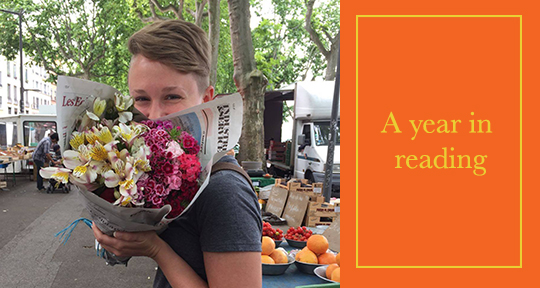Blog Copy Editor Andrea Blatz’s 2018 reading list was packed with nineteenth-century science fiction and women in translation. In today’s post, she discusses the common themes that unite many of these books, among them the experience of trauma and the role of space and place in our lives, before looking ahead to her reading list for the new year!
Like most book lovers, I buy more books than I have time to read, so my “To Read” list is usually longer than my “Already Read” list. Having so many books to choose from for my next read means I usually pick something completely different than the book I’ve just read. However, this year, it seems as though spaces have been a prominent theme in much of what I’ve read.
I started the year with The Other City by Michal Ajvaz, translated by Gerald Turner. After finding a book written in a mysterious script in a bookshop, the narrator begins noticing strange things around him in his home city, Prague. The result is a strange, new reality composed of spaces that are ignored in the daytime. Fish talk to you, tiny elk live on the Charles Bridge, and ghosts appear as the mysterious narrator crosses a boundary into this “other city.”
I spent most of the early summer looking for a book to translate. This meant I spent a lot of time reading French novels, looking for one that my publisher and I both liked. One of them I really liked was Les Adolescents troglodytes by Emmanuelle Pagano (which will be translated and published in Australia). Adèle, the narrator and protagonist, grew up on a farm and leaves as soon she can to undergo a sex change. When she returns, she has a woman’s body, and no one from her past recognizes her. She lives in anonymity as a school bus driver. Throughout the entire novel, we are following Adèle along her bus route and the different spaces bring her to tell the reader about different episodes from her past. While the children she drives to and from school remind her of her own painful adolescence, she also has a close relationship with them. She has an intimate connection to nature in the novel, and it frames her trans identity as a natural occurrence as well as an example of how humans are constantly shifting our definitions of natural. Whether describing the body or the Ardèche countryside, Pagano’s language is sensual and sophisticated, breathing life into the novel.
August was “Women in Translation” month, so, naturally, I took advantage of this as a reason to buy some more books, including Flights by Olga Tokarczuk (translated by Jennifer Croft) and The Passion According to G.H. by Clarice Lispector (translated by Idra Novey). The most intense of these was Blood of the Dawn by Claudia Salazar Jiménez, translated from Spanish by Elizabeth Bryer. The novel tells the stories of three women who lived through the Shining Path insurrection in Peru in the 1980s. All their experiences are different—one is a photographer, one is a villager, one is a guerrilla—, but their paths cross in a particularly violent ending, with all three women experiencing the same pain. Jiménez switches between prose and stream of consciousness to explore how they experience trauma. What struck me throughout the novel was the contrast between life in the city and life in the countryside. Like Ivana Bodrozic does in The Hotel Tito, Jiménez uses her art form to confront her country’s dark history.
I recently shifted the focus of my studies to science fiction and how it depicts the Other, so this fall I’ve been reading a lot of nineteenth century French science fiction, mostly by obscure authors. One of more familiar authors I read was Jules Verne. Verne is one of those authors who is so well-known in American culture that we sometimes forget he wrote in French, and rarely, if ever, do we talk about the fact that as a culture, we only know his works through translation. This is unfortunate, because most of the English translations are re-publications of older translations which generally completely changed his style and deleted huge chunks of the French text. Luckily, a lot of his works have been re-translated in recent years. I read The Sphinx of the Ice Realm, one of his lesser-known works, because I was able to find a solid translation by Frederick Paul Walter. This novel is a sequel to Edgar Allan Poe’s only novel, The Narrative of Arthur Gordon Pym of Nantucket (fun fact: a lot of Poe’s work was translated into French by Baudelaire). It follows the crew of the Halbrane as they attempt to reach the South Pole. On the way, they find out that Poe’s novel was actually the true story of Pym, and in the end, the sailors find his body at the foot of a sphinx-shaped magnetically-charged mountain.
I tried to read more works by women this year, but I noticed that if I don’t make a concerted effort, I end up reading more works by men. In the spring, I took a class on francophone women authors, so I did have the chance to read and discuss some really interesting women’s works (including Maryse Condé’s Moi, Tituba sorcière . . . ). However, I hope to include more women authors in my personal reading next year, especially in science fiction, where women are saying really interesting things about space and place.
Andrea Blatz is a doctoral student in French literature at the University of Texas at Austin. She’s also an emerging translator.
*****
Read more essays on the Asymptote blog:

